Picking Up and Storing
Floating Row Covers
with our home-made "Remay Roller"
by Tom Roberts, Dec-08
Click on photos to enlarge.
Unfortunately we didn't take all the photos we wanted in 2008,
so tune in next summer for the
missing photos below.
Floating Row Covers are Great.
We use floating row covers for insect protection and frost protection on beet greens,
radishes, cabbage, broccoli, Brussels sprouts, spicy greens, cucumbers, and Chinese cabbage. As a
result, we deploy about three or four thousand feet of it each year, and use it for a year or three
until it just wears out from exposure to sunlight and abrasion. It is 86 inches wide and most of it is
cut into 250 to 275 foot lengths which is the length of many of our fields. We use "Agribon"
brand, but everyone I know calls it "Remay", after the original brand that was introduced in the
1980's.
But There was One Problem.
 For years one of the least fun jobs at the farm was rolling up the floating row covers once they were no
longer being used for a crop. Mostly, we folded it in half along its length then knelt down and began
rolling it up, crawling along as we went. When we were done, we had a large ball of row cover that we
could wrap our arms around and clumsily hoist into a garden cart.
For years one of the least fun jobs at the farm was rolling up the floating row covers once they were no
longer being used for a crop. Mostly, we folded it in half along its length then knelt down and began
rolling it up, crawling along as we went. When we were done, we had a large ball of row cover that we
could wrap our arms around and clumsily hoist into a garden cart.
When we wanted to re-use this "ball of Remay", it had to be awkwardly rolled out along the row
to be covered in reverse procedure to the rolling up process.
Our Solution.
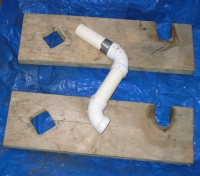 Then about two winters ago, as we sat around the table one night after supper, we began to discuss what
would be the best way to pick up the row covers from the field. That fall, Coco had used a cardboard
roll set on a garden cart to slowly roll the row cover onto. That led us to refine that model using
standard 10 foot sections of 1½ inch PVC pipe instead of cardboard as a roller core and the
rear-mounted tool bar on the tractor as a working station.
Then about two winters ago, as we sat around the table one night after supper, we began to discuss what
would be the best way to pick up the row covers from the field. That fall, Coco had used a cardboard
roll set on a garden cart to slowly roll the row cover onto. That led us to refine that model using
standard 10 foot sections of 1½ inch PVC pipe instead of cardboard as a roller core and the
rear-mounted tool bar on the tractor as a working station.
Jack made a pipe holder from two pieces of eighteen inch long 2x8, each with a 2 inch square hole cut so
they would fit snugly one onto each end of the 2 inch square tool bar. Each of these end pieces also had
a two and a half inch deep, two inch wide notch in the top to set the pipe into. A bit of grease in
these assures a smoother rolling pipe.
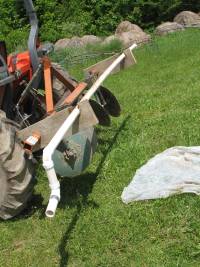 For a crank to rotate the pipe, we used two PVC elbows separated by a 12 inch long piece of PVC pipe,
with an eight inch piece at one end for the crank handle. The friction fit of the lower elbow onto the
rolling pipe is just right to allow using the winding handle to rotate the pipe. The smoothness of the
PVC allows the rolling person's hand to slide around the handle, so it is not necessary to improvise a
rotating handle. Everything in the handle is just pushed together, using no bonding agent between the
pieces. This works because there is so little force involved when winding the row covers onto the pipe.
Wrapping a bit of duct tape around the handle where it fits into the crank made for a tighter fit at
this point where it is exercised the most.
For a crank to rotate the pipe, we used two PVC elbows separated by a 12 inch long piece of PVC pipe,
with an eight inch piece at one end for the crank handle. The friction fit of the lower elbow onto the
rolling pipe is just right to allow using the winding handle to rotate the pipe. The smoothness of the
PVC allows the rolling person's hand to slide around the handle, so it is not necessary to improvise a
rotating handle. Everything in the handle is just pushed together, using no bonding agent between the
pieces. This works because there is so little force involved when winding the row covers onto the pipe.
Wrapping a bit of duct tape around the handle where it fits into the crank made for a tighter fit at
this point where it is exercised the most.
Picking up the Row Covers.
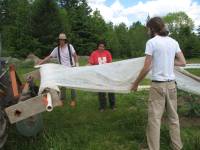 First we walk the row to remove all of the pins ("floating row cover staples") that are
used to keep the row cover in place. Meanwhile the tractor, with toolbar, pipe holders and an empty pipe,
has been backed up to the end of the row, and the crank inserted onto the empty pipe. To pick up our
remay, we use three people. One person slowly turns the crank while the other two pick up the row cover
and start it rolling onto the pipe. Once it catches and begins to pull up the row cover, the cranker
speeds up and one person on each side pulls the remay from off the row while keeping the remay taught so
it doesn't bunch up as it rolls onto the pipe. The third person keeps cranking at a steady pace, and the
row cover rolls onto the pipe at a brisk walking pace. The row cover is best rolled up when fairly dry
and on a day that isn't too breezy.
First we walk the row to remove all of the pins ("floating row cover staples") that are
used to keep the row cover in place. Meanwhile the tractor, with toolbar, pipe holders and an empty pipe,
has been backed up to the end of the row, and the crank inserted onto the empty pipe. To pick up our
remay, we use three people. One person slowly turns the crank while the other two pick up the row cover
and start it rolling onto the pipe. Once it catches and begins to pull up the row cover, the cranker
speeds up and one person on each side pulls the remay from off the row while keeping the remay taught so
it doesn't bunch up as it rolls onto the pipe. The third person keeps cranking at a steady pace, and the
row cover rolls onto the pipe at a brisk walking pace. The row cover is best rolled up when fairly dry
and on a day that isn't too breezy.
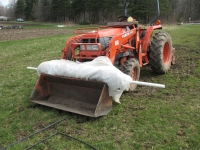 Once the roll is full (a 275 foot piece of row cover makes a roll about 15 inches in diameter), the crank
is pulled off the pipe, and the roll is lifted out of the pipe holders and brought to the front of the
tractor where it is stacked on the bucket arms. The tractor is then re-positionsed to roll up the next
row cover. Our tractor can easily hold six to eight rolls this way before having to unload. Once the pins
are pulled, rolling up a row cover takes about five minutes and results in a neat, easily transported
package. For shorter lengths of row cover, one after another can be fed onto the same roll, but if you
have both long lengths and short lengths, remember to label your pipes as to which is which.
Once the roll is full (a 275 foot piece of row cover makes a roll about 15 inches in diameter), the crank
is pulled off the pipe, and the roll is lifted out of the pipe holders and brought to the front of the
tractor where it is stacked on the bucket arms. The tractor is then re-positionsed to roll up the next
row cover. Our tractor can easily hold six to eight rolls this way before having to unload. Once the pins
are pulled, rolling up a row cover takes about five minutes and results in a neat, easily transported
package. For shorter lengths of row cover, one after another can be fed onto the same roll, but if you
have both long lengths and short lengths, remember to label your pipes as to which is which.
An Added Benefit.
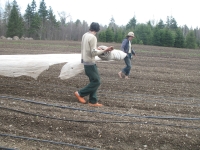
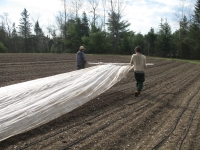 This year we discovered to our delight that using this system also makes un-rolling of the row covers onto
the next crop even easier than using brand new row covers. After anchoring the loose end of the row
cover at one end of the row, two people, one on each end of the pipe, can walk down the row at a brisk pace
as the row cover unrolls from the pipe as they go. Since the PVC pipe is so smooth, if loosely held it simply spins in
their hands as they walk, so there is no need to rotate the pipe while walking.
This year we discovered to our delight that using this system also makes un-rolling of the row covers onto
the next crop even easier than using brand new row covers. After anchoring the loose end of the row
cover at one end of the row, two people, one on each end of the pipe, can walk down the row at a brisk pace
as the row cover unrolls from the pipe as they go. Since the PVC pipe is so smooth, if loosely held it simply spins in
their hands as they walk, so there is no need to rotate the pipe while walking.
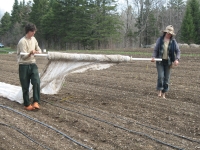 As often as needed—usually about every 75 feet—they stop to pin down the row cover so that the
wind won't blow it off. Once they are at the end of the row, if there is still a little of the roll left, it
can be set on the ground to await re-rolling once that crop no longer needs the row cover.
As often as needed—usually about every 75 feet—they stop to pin down the row cover so that the
wind won't blow it off. Once they are at the end of the row, if there is still a little of the roll left, it
can be set on the ground to await re-rolling once that crop no longer needs the row cover.
In the lower photo, Jarrett is on the left and he is using this system for the first time. In his right hand
are a fistfull of remay staples. Coco is on the right and she is primarily repsonsible for inventing this
system.
Storing the Row Covers for the Winter.
The rolls of row covers take up considerable space, and altho one person can move them about easily
enough, there is a tendency to leave them outdoors or in a pile on the floor of a shed. This not only
attracts rodents to this lovely and warm chewable world, but makes that area unusable for anything else.
After a year of using the remay roller, we decided that there was a need for a custom-made place to
store the pipes of remay.
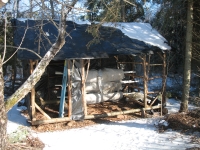 In late November, Tom built a 7' x 14' shed from spruce poles cut from the woods. The roof and two sides
covered with 15 mil black pool-covering plastic that a recycler dropped off at our farm. In the shed are
four racks consisting of two sets of four seven foot long poles running from the back to the front. The
racks are eight feet apart, allowing the rolls of looseley rolled 7 foot wide rmay to easily fit between
them. The ten foot pipes extend 20 inches past the remay on each side, and it is the pipes which sit on
the racks. One or two people can store the Remay rolls by walking into the shed holding the
Remay-on-a-pipe, putting one side of the pipe and then the other onto the racks, then sliding the roll
to the back. The shed can easily accomodate thirty rolls of Remay.
In late November, Tom built a 7' x 14' shed from spruce poles cut from the woods. The roof and two sides
covered with 15 mil black pool-covering plastic that a recycler dropped off at our farm. In the shed are
four racks consisting of two sets of four seven foot long poles running from the back to the front. The
racks are eight feet apart, allowing the rolls of looseley rolled 7 foot wide rmay to easily fit between
them. The ten foot pipes extend 20 inches past the remay on each side, and it is the pipes which sit on
the racks. One or two people can store the Remay rolls by walking into the shed holding the
Remay-on-a-pipe, putting one side of the pipe and then the other onto the racks, then sliding the roll
to the back. The shed can easily accomodate thirty rolls of Remay.
The shed was made extra wide to also accomodate wire hoops for slitted row covers, as these too needed a
place to live during the off-season.
|
![[Snakeroot Organic Farm logo]](pix/sof.gif)











